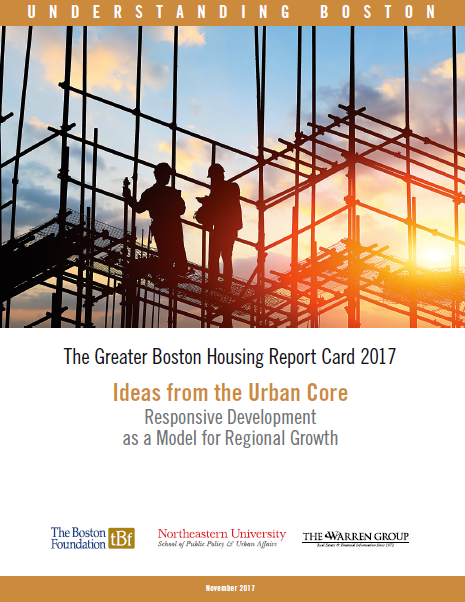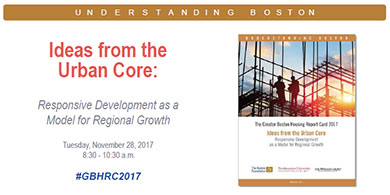Greater Boston Housing Report Card 2017
Ideas from the Core: Responsive Development as a Model for Regional Growth
November 28, 2017
The City of Boston is setting an example for getting multi-unit housing permitted and built in Greater Boston, but income inequality continues to slow housing growth, according to the authors of the 15th annual Greater Boston Housing Report Card. The report finds a combination of incentives and improved permitting processes has helped turn around 2016’s decline in new housing permits, but that a smaller percentage of those permits are for affordable units.
The 2017 report, entitled Ideas from the Urban Core: Responsive Development as a Model for Regional Growth, finds that Boston has granted nearly 60% of the housing permits issued for buildings of five or more units this year, and over 41% of all new housing permits this year, nearly double its share just five years ago. The city has benefited from strong demand and a streamlined approval process, which has cut the time needed to secure a permit from over 400 days to just 120.
Overall, an estimated 12,900 permits will be issued in Greater Boston in 2017 – up about 12% from 2016. However, affordability remains an issue in the city and throughout the five counties (Essex, Middlesex, Norfolk, Plymouth and Suffolk) in the Greater Boston region. The number of permits issued outside of the city of Boston actually declined in 2017, and the most recent data (from 2015) show that more than half of renters and 36% of homeowners with mortgages are paying more than 30% of their income on housing.
New affordable housing stock is slow to come online, too, even in Boston. Just 18% of new units to market since 2011 were affordable – less than half the rate of 1996-2003.
“Even in Boston, there continues to be a challenge of creating a housing stock that benefits working households— along with everyone else who strives to live in the city,” noted Barry Bluestone, lead author of the report this year as he has been for the entire series. “Throughout the region, we need to make a renewed commitment to use and expand the resources available to create housing that fits the overall needs of lower- and middle-income workers – from leveraging Chapter 40R to build more transit-oriented housing to thinking about smaller units that can fit the needs of millennials and older residents who are seeking smaller, but convenient units.”
To that end, Bluestone and his team recommend a 10-point plan for development of what they refer to as “21st Century Villages,” multistory, mixed-income buildings made up of smaller units with community spaces ideally situated near public transit. The village units would be a mix of sizes – from “micro” units to multi-bedroom ones. They would be designed using new high productivity building techniques and destined to serve the needs of two rapidly growing demographic groups: millennials age 20-34 who are coming here as graduate students, medical interns and residents, and other young professionals and aging in place between now and 2030 and those over age 60.
The plan would bring together political, civic, architectural and construction interests to design and site the developments – noting that coordination would be critical for the village concept to succeed.
The report also highlights positive policy changes at the city and state-level to leverage resources and create more affordable workforce housing and assist homeowners, but it notes those changes come at a time when state and federal spending on housing and homelessness are sliding. Together, state and federal spending is expected to fall by over $100 million dollars in FY2018.
Other key data points:
- Current estimates for 2017 suggest an 11.7 percent decline in single-family home sales by the end of the year. If this projection is true, 2017 will mark the largest year-over-year decline in single-family homes sales since 2005.
- Distance from Boston has proven to be a major factor in price appreciation. In some small suburban communities farther away from Boston, median prices today are still as much as 30 percent lower than in 2005, but communities nearest to Boston have seen their home prices explode: Cambridge leads by far with a median selling price of single-family homes up 85 percent since 2005. Lexington is second at 63 percent; Somerville and Brookline both at 62 percent; and Boston at 55 percent.
- Boston neighborhoods are not immune to price appreciation. Since 2005, home prices in South Boston and Jamaica Plain have risen 71 and 83 percent, respectively. And the “affordable” neighborhoods of Roxbury, East Boston and Mattapan have experienced price increases of 70, 52 and 50 percent, respectively.
- More affordable nearby communities are dealing with a sharp price spike. In Everett, the median selling price of a single-family home has leapt by a remarkable 33 percent just since 2015—from $307,500 to $410,000. In Lynn, the median price has jumped 20 percent from $278,250 to $335,000, and in Malden prices are up 19.5 percent to $430,000.
- Even farther from the city, median home prices are rising in Peabody (up 6%), Lowell (up 9.6%) and Lawrence (up 14.2%) since 2015 – with Lawrence outpacing even places like Brookline and Newton.
- For renters, there are signs of a stabilization. In the inner core of the Greater Boston region the median rent in mid-2017 was marginally lower than in 2016. This was the first time that rents have fallen since at least 2009. The decline is less than 3 percent, but this compares with an average annual increase of 6.9 percent over the period 2009–2016. Even as average rents have fallen, however, the proportion of renters who are housing cost–burdened continued to rise in 2017 – to over 52%.
- Condominium sales are projected to decrease in 2017 given the sales volume through the middle of the year. In this case, total condo sales will come in at just over 18,100 units, a 4.1 percent decrease from 2016. While this year will likely mark the first decline in condo sales in Boston proper since before 2011, more affordable but nearby communities such as Quincy continue to see sales growth.


